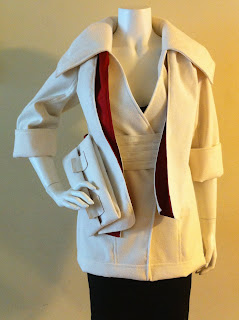Friday, October 15, 2010
Frequently Asked Questions
I receive many etsy emails asking the same questions about an item. I decided I'm going to put a frequently asked questions t the bottom of every description. But its hard for me because I'm not the buyer to fully understand what people have questions about. Please help!
Wednesday, October 6, 2010
Just ask Wikipedia
No I dont sew, YES am a designer... just ask wikipedia
Fashion design terms
- A fashion designer conceives garment combinations of line, proportion, color, and texture. While sewing and pattern-making skills are beneficial, they are not a pre-requisite of successful fashion design. Most fashion designers are formally trained or apprenticed.
- A pattern maker (or pattern cutter) drafts the shapes and sizes of a garment's pieces. This may be done manually with paper and measuring tools or by using an AutoCAD computer software program. Another method is to drape fabric directly onto a dress form. The resulting pattern pieces can be constructed to produce the intended design of the garment and required size. Formal training is usually required for working as a pattern marker.
- A tailor makes custom designed garments made to the client's measure; especially suits (coat and trousers, jacket and skirt, et cetera). Tailors usually undergo an apprenticeship or other formal training.
- A textile designer designs fabric weaves and prints for clothes and furnishings. Most textile designers are formally trained as apprentices and in school.
- A stylist co-ordinates the clothes, jewelry, and accessories used in fashion photography and catwalk presentations. A stylist may also work with an individual client to design a coordinated wardrobe of garments. Many stylists are trained in fashion design, the history of fashion and historical costume, and have a high level of expertise in the current fashion market and future market trends. However, some simply have a strong aesthetic sense for pulling great looks together.
- A buyer selects and buys the mix of clothing available in retail shops, department stores and chain stores. Most fashion buyers are trained in business and/or fashion studies.
- A seamstress sews ready to wear or mass produced clothing by hand or with a sewing machine, either in a garment shop or as a sewing machine operator in a factory. She (or he) may not have the skills to make (design and cut) the garments, or to fit them on a model.
- A teacher of fashion design teaches the art and craft of fashion design in art or fashion school.
- A custom clothier makes custom-made garments to order, for a given customer.
- A dressmaker specializes in custom-made women's clothes: day, cocktail, and evening dresses, business clothes and suits, trousseaus, sports clothes, and lingerie.
- An illustrator draws and paints clothing designs for commercial use.
- A fashion forecaster predicts what colours, styles and shapes will be popular ("on-trend") before the garments are on sale in stores.
- A model wears and displays clothes at fashion shows and in photographs.
- A fit model aids the fashion designer by wearing and commenting on the fit of clothes during their design and pre-manufacture. Fit models need to be a particular size for this purpose.
- A fashion journalist writes fashion articles describing the garments presented or fashion trends, for magazines or newspapers.
- An alterations specialist (alterationist) adjusts the fit of completed garments, usually ready-to-wear, and sometimes re-styles them. NOTE: despite tailors altering garments to fit the client, not all alterationists are tailors.
- An Image Consultant, wardrobe consultant or fashion advisor recommends styles and colors that are flattering to the client.
Tuesday, October 5, 2010
My policies are my protection
My policies are my protection. Though after re writing my policies in order to be protected my sales have decreased slightly (Im assuming my policies present a risk people do not wish to take). But decrease or not I cannot be screwed over anymore.
But of course there are always those people who could care less what the policies say and threaten you. That is the worst and really gets to me. I'm very slowly learning how to speak to them and make people understand I am not a retail store. How do I get the threats to stop all together? I don't know.
Here is an etsy item I need to wear to remind me to just stay calm.

Friday, October 1, 2010
Creative Customers


Subscribe to:
Posts (Atom)
